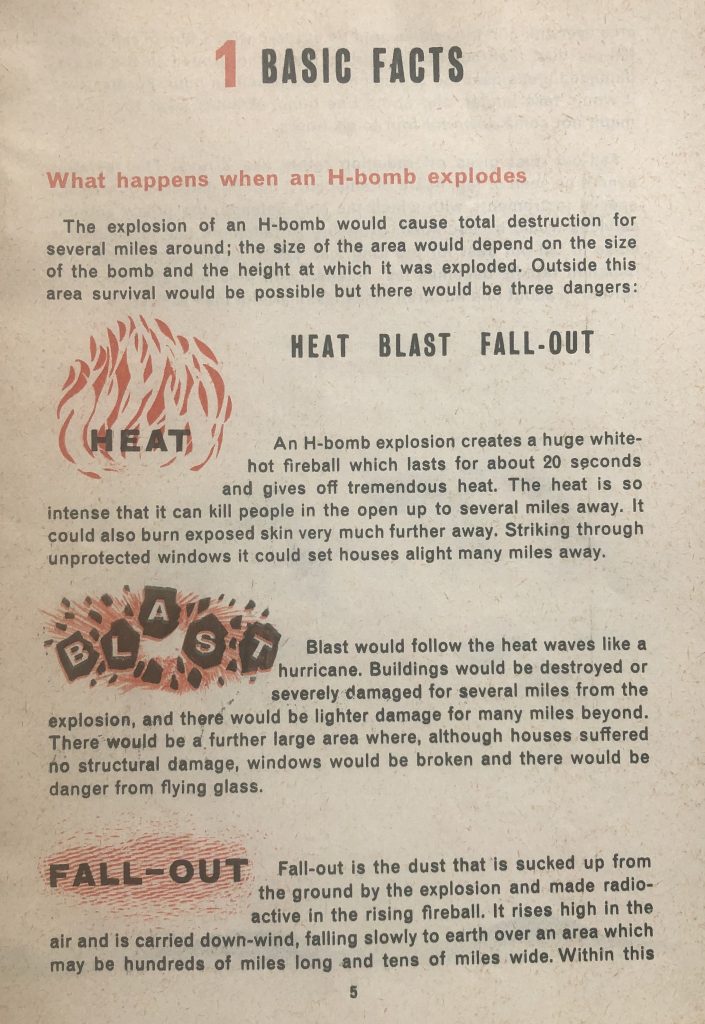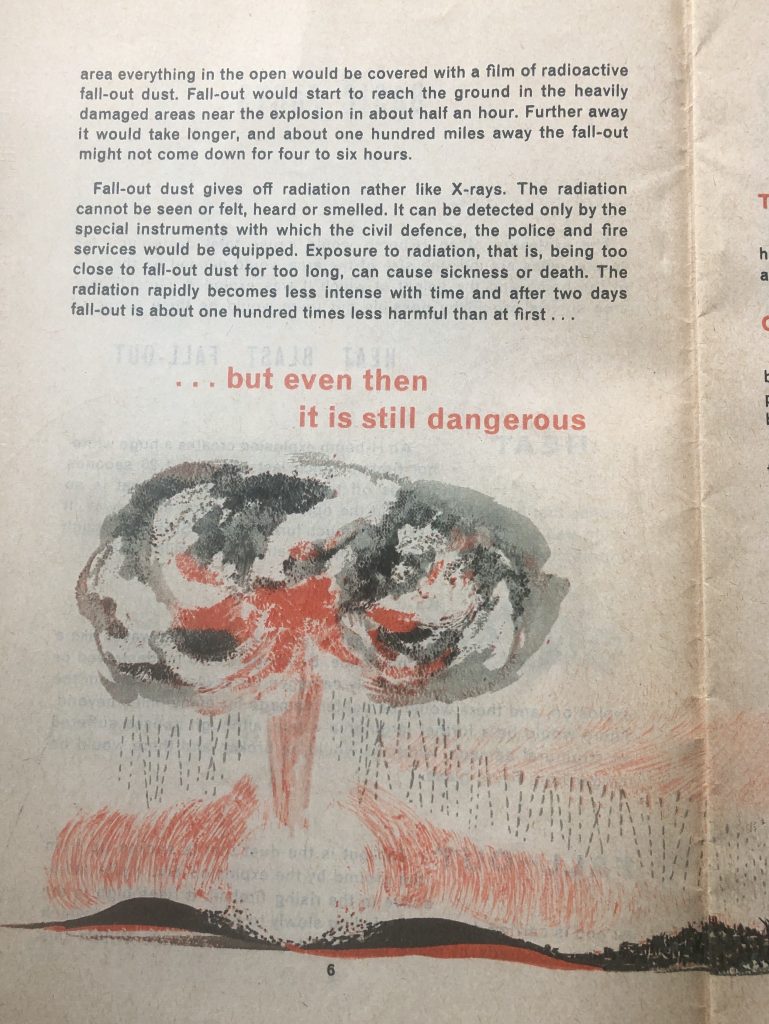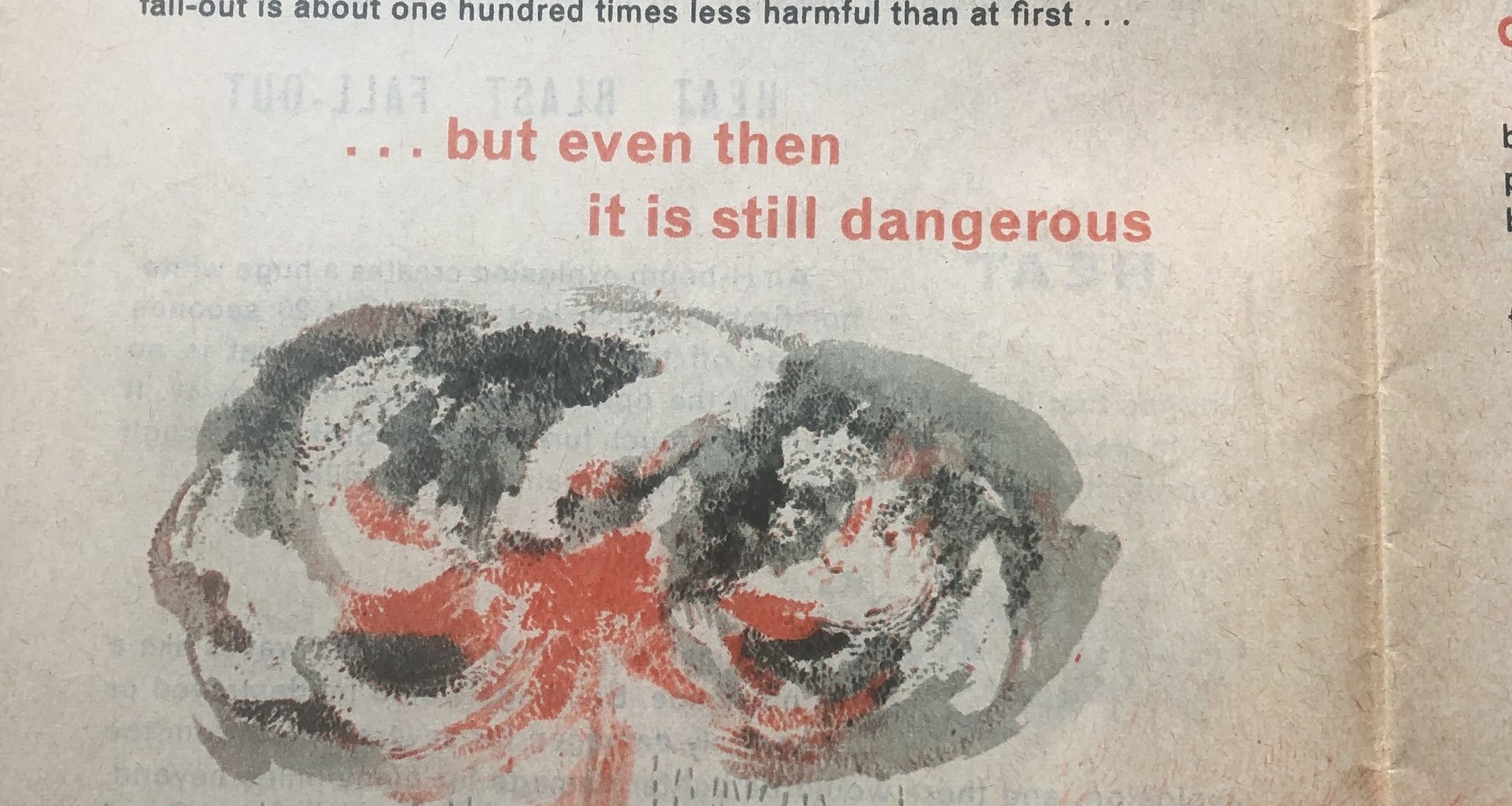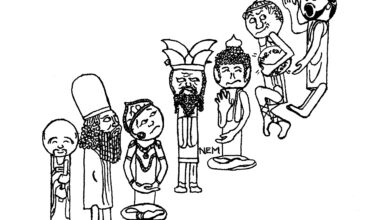
The threat of nuclear war has loomed above the horizon again recently. In the circumstances, it is perhaps worth reminding oneself why it would still be a very, very bad idea. The Freethinker has put together a brief list of books, a film and a song that imagine, in particularly compelling ways, how nuclear war or a similar catastrophe might come about, and what it would be like – or, in the case of Hiroshima and Nagasaki, and the disaster at Chernobyl, how it actually was.
One of the traditional themes of the arts is the disastrous consequences that might arise when human inventiveness is combined with human irrationality. But can the creative imagination help to forestall the apocalypse? As Virgil put it in the first century BC, ‘my poems are as effective against the weapons of war as doves are against an eagle.’* And that was long before mutual assured destruction was a thing.
The images accompanying this list are taken from a 1963 Home Office leaflet entitled Civil Defence Handbook No. 10: Advising the Householder on Protection against Nuclear Attack. As discussed by David Welch in Protecting the People: The Central Office of Information and the Reshaping of Post-War Britain, 1946-2011 (British Library, 2019), the handbook was produced in the wake of the Cuban Missile Crisis by a state that wanted to reassure the population, without necessarily being able to imagine what such a catastrophe would be like. The graphic designs, in black, red and grey, are simplified and almost appallingly restrained. ‘Remember fall-out’, its pages warn in an ineffectual mantra. Keep calm and carry on?

~ Books ~
Hiroshima, John Hersey (1946, republished with a new final chapter in 1985). Link here
This book, by the American journalist John Hersey, records the memories of survivors of the first atomic bomb to be dropped in anger – on Hiroshima in southern Japan, on 6th August 1945. (Nagasaki followed three days later.) Somewhere between 90,000-146,000 people, mostly civilians, are estimated to have been killed by ‘Little Boy’, as the bomb was somewhat tastelessly nicknamed.
Hersey used a narrative style to bring alive the interwoven stories of six survivors: a clerk, a physician, a tailor’s widow, a German Jesuit priest, a surgeon and a pastor. The story starts with the ‘noiseless flash’ that occurred at the moment of impact. It then traces the subsequent carnage, as described by its witnesses: the schoolgirls trapped under a fence and singing the national anthem until they died of suffocation, or the victims of radiation burns whose ‘skin slipped off in huge, glovelike pieces’.
One striking effect of the flash produced by the bomb on impact was to imprint ‘shadows’ cast by one building on another. There were even places where ‘vague human silhouettes’ were discerned on the concrete and stone that remained, whether of a ‘man about to whip his horse’, or a painter ‘in the act of dipping his brush into his paint can’ – just as, in the volcanic eruption at Pompeii two thousand years earlier, the ash preserved the shapes of a running dog or a mother cradling her child.
Hersey then turns to the after-effects, including psychological trauma and the debilitating radiation sickness that the survivors all experienced in different ways, including hair loss, wounds that refused to heal, and petechiae – ‘hemorrages about the size of grains of rice, or even as big as soybeans,’ that appeared on the surface of the skin. Above all, the hibakusha, or ‘explosion-affected persons’, as the bomb survivors became known, were prone for months and years afterwards to ‘a nagging weakness and weariness, dizziness now and then, digestive troubles, all aggravated by a feeling of oppression, a sense of doom…’.
All this from a ‘primitive’ nuclear bomb, much less powerful than those paraded today before admiring crowds in Russia, China or North Korea, or lurking, presumably, in American submarines.
Lord of the Flies, William Golding (1954). Link here
Set in a near-future where an ‘atom bomb’ has exploded, Golding’s classic imagines what would happen to children – or to any survivors – without the structures of civilisation to impose some sort of order. A plane with a group of boys headed to safety crash-lands on a desert island. We hear nothing about the England they have left or the effects of the bomb, except what one of them heard from the pilot: ‘They’re all dead.’ The new land seems like a paradise, but the boys, or most of them, degenerate bit by bit into savages, first painting their faces, then killing a pig with crude spears, and finally hunting each other.
At the end, with the island burning like an inferno around him, Ralph, the last more or less humane boy left standing, weeps helplessly ‘for the end of innocence, the darkness of man’s heart,’ and the murder of his ‘true, wise friend called Piggy’ – the most intelligent of the boys but a physical weakling who, without the protection of adults, has become a victim of the others’ violence.
On the Beach, Nevil Shute (1957). Link here
World War III has happened. Thousands of nuclear bombs have been dropped across the northern hemisphere, sending up a vast cloud of radioactive dust that has killed all human life there and is now drifting gradually and relentlessly southwards. The plot traces the reactions of a group of people near Melbourne as they await its arrival: a naval officer and his wife, Peter and Mary Holmes, and their baby daughter, along with an American submarine commander, an unstable young woman, and a scientist. As the towns of northern and central Australia go ‘out’ one by one, each of the survivors retreats into their own fantasy world to try to bear the unbearable.
Just before they all die, Peter and Mary wonder whether the all-out war could have been avoided. But as Peter puts it, ‘if a couple of hundred million people all decide that their national honour requires them to drop cobalt bombs upon their neighbour, well, there’s not much that you or I can do about it.’ The only hope, he speculates, might have been education or through the newspapers, but in the event they, too, failed. As the cloud of fall-out moves closer, the family start to experience radiation sickness. Peter injects the baby with government-supplied cyanide, and then he and his wife lie down and take theirs together.
Shute’s prose style is all the more devastating for being direct and unadorned. How could human life end? This is how.
When the Wind Blows, Raymond Briggs (1982). Link here
Briggs had achieved fame for The Snowman (1978) and his two Father Christmas graphic novels (1973, 1975). His story about a nuclear attack on Britain, published a few years later, effectively exploited the cognitive dissonance produced by using the same familiar, comfortable style of cartoons for a deeply uncomfortable subject.
Jim and Hilda Bloggs, a retired, working-class couple living in the countryside, are going about their everyday lives when it is announced over the radio that the ‘international situation’ is ‘deteriorating and an ‘outbreak of hostilities’ is due to take place in three days. ‘It looks as if there’s going to be a War, dear,’ Jim says to his wife, almost casually. ‘Well, we survived the last one,’ she says, ‘we can do it again.’ The book plays on this contrast between the bombings of World War II, which is all of the couple’s experience of conflict, and nuclear war, which they are fatally slow to comprehend.
When he hears the broadcast, Jim cycles off to buy bread, but it is all sold out. ‘There seems to be some sort of panic purchasing,’ he tells his wife, innocently. As this remark suggests, the couple – like everyone else – are totally unprepared for the consequences of the explosion. They try to follow the instructions in leaflets provided by the authorities, but these turn out to be almost laughably inadequate. For instance, Jim stores drinking water in bottles, but they are shattered by the blast.
The story is interspersed with shadowy pictures of a warhead, a group of bombers, and a nuclear submarine. Briggs emphasises the strangeness that such ‘distant’ scenes should be able to destroy the everyday life of people thousands of miles away. While Jim follows the news as best he can, Hilda has little interest in international politics. As Jim says, ‘it’s all very complicated, ducks.’ He imagines that the responsibility lies with committees, who ‘have loads and loads of meetings and thus Arrive at Decisions.’ Neither of them really understands why nuclear war should happen; but then, Briggs implies, can there be any rational explanation?
Even when, after the explosion, they discover there is no water, no electricity, and all the countryside around the has been razed to the ground, the couple preserve a tragically naïve optimism, almost to the end, that they will be rescued. As Jim puts it, ‘the Govern-mental Authorities have been aware of this eventuality for years, so Contingency Plans will have been formalated long ago.’
Inevitably exposed to radiation, their faces become greener; Hilda’s hair starts falling out; Jim’s gums start to bleed; and they are wracked by thirst. Their last resort is to shroud themselves in paper bags and crawl into their useless fallout shelter, where, alone and dying, they pray to God, or someone.
Chernobyl Prayer: A Chronicle of the Future, Svetlana Alexievich (1997, revised 2013). Link here
This book chronicles the Chernobyl explosion of 26th April 1986 in Ukraine, close to the border with Belarus, and its aftermath. It uses Alexievich’s distinctive technique, somewhere between reportage and dramatic monologue, of piecing together the past through the voices of its survivors. The story is all the more harrowing for being told through the experiences of ordinary people whose lives were ruined all at once, with no warning either of the meltdown of the reactor itself or of the radiation sickness that would follow.
For Alexievich, ‘the accident at Chernobyl was the gravest technological catastrophe of the twentieth century,’ and serves as a warning for the future. Previously, she argues, humanity’s main sources of ‘horror and dread’ were from war. But with the advent of nuclear technology, whether weapons or reactors, ‘the history of disaster has begun.’ Faced with the empty, contaminated ‘Zone’ around Chernobyl, we can no longer feel confident that ‘life will be beautiful’ forever.
Svetlana Alexievich’s works examine the history of the former USSR by delving deep into the memories of those who lived through it. She won the Nobel Prize for Literature in 2015.
The Book of Revelation (c. 1st century AD). Link here
It is a curious fact that one of the earliest visions of worldwide catastrophe – the original apocalypse – can be found in the New Testament. ‘Love is patient, love is kind,’ Paul says in I Corinthians, ‘it always protects, always trusts, always hopes, always perseveres.’ Yet the whole moral basis of Christianity is defined by reference to the end of the world and the destruction of everything that humans have made. It is the ultimate revolution, the ultimate assertion of power by a hostile force. In a world of atomic bombs, the account of the Doomsday by John of Patmos sounds strangely familiar:
‘And I heard a great voice out of the temple saying to the seven angels, Go your ways, and pour out the vials of the wrath of God upon the earth. And the first went, and poured out his vial upon the earth; and there fell a noisome and grievous sore upon the men which had the mark of the beast, and upon them which worshipped his image. And the second angel poured out his vial upon the sea; and it became as the blood of a dead man: and every living soul died in the sea. …
‘And the fourth angel poured out his vial upon the sun; and power was given unto him to scorch men with fire. And men were scorched with great heat, and blasphemed the name of God, which hath power over these plagues: and they repented not to give him glory. And the fifth angel poured out his vial upon the seat of the beast; and his kingdom was full of darkness; and they gnawed their tongues for pain…’ (Rev. 16.1-3, 8-10)
According to the author, the destruction of the wicked world was, in true revolutionary spirit, to be followed by the creation of a ‘new heaven and a new earth’. It’s the sort of attitude that induces people to blow themselves up, commit mass suicide, or generally despise this world. Unfortunately, outside the realms of mysticism or fiction, new worlds to replace it are in short supply.

~ Film ~
Dr Strangelove, or, How I Learned to Stop Worrying and Love the Bomb (1964). Director: Stanley Kubrik. Link here
If On the Beach should be required reading for anyone with an interest in humanity’s survival, Dr Strangelove should be required watching. Stanley Kubrik’s black comic masterpiece traces the gripping, hilarious and terrifying story of what happens when a US general goes rogue and decides to launch a nuclear strike against the USSR. Unfortunately, the Russians have invented a ‘doomsday machine’, which will automatically set off further nukes around the world in response to any American attack.
Peter Sellers, one of the great comic actors of the twentieth century, plays three roles: an RAF captain, a Nazi-turned-nuclear-weapons-expert, and the US president. As Brigadier General Jack D. Ripper (Sterling Hayden) tries to launch his attack, the safety procedures kick in one by one, but not soon enough to prevent an insane air force major on one B-52 bomber, played by Slim Pickens, from flying beneath the Russians’ radar and riding on the back of a warhead down to his doom – and everyone else’s.
Kubrik’s choice to film in black and white rather than technicolour makes the movie seem almost like an old-fashioned newsreel, and thus much more like something which could happen than mere fantasy. After the ‘doomsday machine’ is detonated, the film ends with clips of real nuclear explosions taken from US footage of tests in the ’40s and ’50s. The distinction between what has happened and what might happen, between a test run and the real thing, comedy and apocalypse, may be only a matter of chance.
~ Song ~
Twenty Tons of TNT, Michael Flanders and Donald Swann (1967). Link here
‘I have seen it estimated
Somewhere between death and birth,
There are now three thousand million
People living on this earth;
And the stock-piled mass destruction
Of the nuclear powers that be
Equals for each man or woman
Twenty tons of TNT.’
So begins one of the few serious songs by the most civilised of entertainment duos, whose repertoire was usually so light-hearted and playful. Flanders and Swann employed a very simple, almost chant-like melodic structure, sustained by an ominous drumbeat, to emphasise the starkness of the prospect. The ‘legacy’ of ‘twenty hundred years of teaching’, of ‘Plato, Buddha, Christ and Lenin’, and all human culture, would equally be reduced to ‘twenty tons of TNT’.
That was in 1967: today, the calculation might be different. If there are more than twice as many people today, there is doubtless also far more than twice as great a tonnage of nuclear weaponry just waiting to be set off, whether by megalomaniac, fanatic or chance. ‘Ends the tale that has no sequel’ – and that would be that.
*sed carmina tantum / nostra valent, Lycida, tela inter Martia quantum / Chaonias dicunt aquila veniente columbas (Ecl. IX.11-13).









Your email address will not be published. Comments are subject to our Community Guidelines. Required fields are marked *
Donate